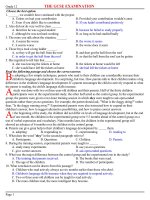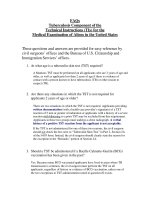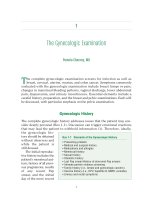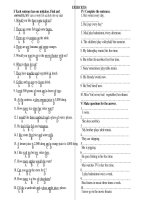The ophthalmic examination equine
Bạn đang xem bản rút gọn của tài liệu. Xem và tải ngay bản đầy đủ của tài liệu tại đây (2.42 MB, 85 trang )
The Ophthalmic Examination
Equine
Jim Schoster, DVM DACVO
Copyright Schoster 2003
INTRODUCTION
There are enough special characteristics to an equine
ophthalmic examination that it is important to address this topic
individually.
Some techniques used in other species, namely the dog and
the cat, can apply but usually require adaptation.
Even though the equine eye is much larger than a cat or dog
eye it can be much more difficult to examine. This is mainly
because of the size and strength of the animal. In addition to
the increase in ocular size also comes a much larger and
stronger orbicularis oculi muscle.
History
Prior to any examination a good history is
essential. Questions not only relating to the chief
complaint and recent history, but also to previous
ocular problems with this animal and relatives as
well as any current or past problems with animals
stabled in the same environment.
A complete history will often aid in determining the
nature and cause of the problem by assisting the
examiner in knowing where to place the emphasis
during the examination and perhaps direct the
laboratory submissions as well.
The Ophthalmic Examination
Examination Environment
The examination environment is important and can greatly
influence the examination results. In an environment that is too
distractive and bright, a complete careful examination can not be
done; especially in an animal that is unruly.
Safety for the examiner and his assistants is also a major
concern and will be diminished if the environment is not
adequate.
Try to locate a non-confined area that is away from the general
activity, provides adequate lighting which can be reduced when
necessary, and ideally has a firm structure to secure the halter
lead to if necessary.
A model examination area would consist of a room or area that
could be isolated, and included a stocks with a non-slip floor.
Introductory Examination Process
Initially a cursory physical examination and
gross examination of the head and ocular
region prior to any sedation or local
anesthesia is advisable.
First and foremost one should
determine if the animal is sighted
The menace response is
acceptable, but even prior to that,
note how the animal is reacting to
its surroundings. For example,
how the animal behaves while
being unloaded from a trailer, or
while turned out in the paddock.
Watch carefully as the animal is
being led on a lead and how it
reacts to other animals and its
environment.
First and foremost one should
determine if the animal is sighted
An obstacle course would be ideal yet in my
experience it is not always practical. Ideally,
evaluation in dim light should also be
allowed, especially with the Appaloosa who
can be affected by Congenital Stationary
Night Blindness (ENB).
First and foremost one should
determine if the animal is sighted
The history with these animals will commonly
include frequent trauma and difficulty
navigating at night or in dim light. These
animals will not have any ophthalmoscopic
lesions. An electroretinogram (ERG) is
necessary to confirm the diagnosis; however,
in the absence of an ERG, considering the
breed, history and clinical findings, a
diagnosis of ENB can be strongly suspected.
Vision Testing
The menace response is a learned response which will not
generally be present in foals less than two weeks of age. A hand
or finger(s) thrust is made toward the eye, avoiding setting up
stimulating air currents, or touching tactile hairs (vibrissae). The
reflex blink is the end point. Therefore, the seventh cranial nerve
and orbicularis oculi muscle must also be intact along with visual
pathways up to and including the cortex. When performing this
test the examiner should stand on one side of the animal to
assure that his hand motion is not in the visual field of the
contralateral eye. The strength of the blink response can be
amplified by actually touching the periocular region on the first
one or two thrusts and then stopping short of this on the next two
or three. Some animals need to be reminded, if you will, that the
thrusted finger may touch them.
Vision Testing
Throwing cotton balls, wads of cotton or a glove
in the air can be helpful in visual assessment but it is
not always reliable.
Vision Testing
The end point with this method would be head
motion and /or reflex blink, which can be subtle. The
examiner needs to be assured that the object thrown
is large enough to be seen, that the object does not
make a noise, set up stimulating air currents, nor is
thrown into the visual field of the opposite eye. A few
repeated responses are necessary to avoid
interpreting a coincidental blink or head motion with
a positive sign. Too many stimuli in a row, however,
will progressively lessen the blink response.
Vision Testing
Throwing Cotton Balls
Gross Evaluation
Symmetry
Ocular discharge
Normal Position of the Upper Eyelid Cilia
Ptosis
Blepharospasm
Photophobia
Surface Topography
Pupillary symmetry
Symmetry
Evaluate symmetry of the
head and facial expression.
Step back and compare the
palpebral fissures for their
size and congruity. Check
the ocular motility, position of
the upper eyelid cilia and
lids.
Ocular discharge
Ocular discharge
if present should be
characterized as
serous, mucoid,
purulent,
hemorrhagic,
seromucoid,
mucopurulent, or
serosanguinous.
Normal Position of the Upper Eyelid Cilia
The position of the
upper eyelid cilia
normally should be
directed nearly
perpendicular to
the corneal surface.
Subtle Ptosis
Subtle ptosis or
drooping of the eyelid
without noticeable
narrowing of the fissure,
as seen with Horner's
or partial facial palsy,
would be detected by
observing the more
ventrally directed cilia.
Blepharospasms
Blepharospasm (forced blinking) is usually a
sign of ocular pain and commonly is also
associated with an ocular discharge.
Photophobia
Ocular pain that results in
blepharospasm can stem
from superficial sites (eg:
cornea) or deep
intraocular ones (eg:
uvea-ciliary spasm).
Intraocular inflammation
will make the animal have
a light (dazzle) induced
(reflex blink)
blepharospasm;
commonly referred to as
Cartoon by Milton Wyman OSU
photophobia.
Surface Topography
Surface topography of the
periorbital and ocular structures
such as eyelid creases and folds,
as well as the supraorbital fossal
depression may be accentuated
or lost. Conditions resulting in
enophthalmia such as a painful
globe or a globe undergoing
atrophy (phthisis bulbi) and loss
of orbital contents due to
emaciation, muscle atrophy
(denervation, post inflammatory)
would emphasize these
topographical structures.
Surface Topography
Conversely, conditions that would increase
the orbital contents such as inflammation,
hemorrhage or obliterate these.glaucoma
would diminish and/or obliterate these.
Careful comparison of both orbital and periocular areas, along with the appreciation of
these surface topographical structures, can
assist in the early recognition of ocular
problems.
Palpation
Palpation of the orbital zone is also important to confirm
topographical changes and characterize them as hard or
soft, moveable or fixed, and sensitive or insensitive.
Percussion of the frontal and maxillary sinus area may be
indicated, especially in animals with orbital disease. A
stethoscope is helpful to critically assess the sounds
generated during percussion and certainly comparison of
both sides will identify subtle fluid accumulations.
Retropulsion
Retropulsion or pushing the globe deeper into the
orbit through the closed eyelids is a technique that is
used to determine if there is an abnormal amount of
orbital contents. Resistance to retropulsion,
especially as compared to the contralateral orbit
would signify increased orbital mass and perhaps a
localization of a focal swelling could be identified with
this method combined with the direction of any
apparent deviation of the globe. This technique would
not of course be used in an eye that is in danger of
rupture. The maximal amount of valuable information
gained from the findings of these procedures results
when the examiner is familiar with the normal bony
and soft tissue anatomy.
Palpation
Palpation used in a stimulatory manner (Palpebral
Reflex) to evaluate sensory and motor nerve
function is important to evaluate the fifth, sixth and
seventh cranial nerves. Touching the periocular
area should normally produce a blink reflex,
verifying that the fifth and seventh cranial nerves
are intact as well as the orbicularis oculi muscle.









